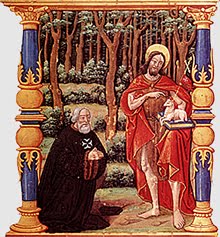 |
| The Madonna of the Serpent, by our confrere Carravaggio. This painting shows us the fruits of our holy anticipation in these coming weeks. |
CHAPLAIN'S ADVENT REFLECTION
Some of us will not
look back with unalloyed pleasure on the year that has just past. Generally in
the public sphere at least good news has been scarce. We are challenged at
every level by uncertainty and insecurity. That should provide us with
opportunities for deeper reflection and more insistent prayer. Faith can carry
us through the darkest valley and offer hope where all else appears of no
avail. The lessons as well as the experience of the past provide some answers
as well as demonstrating both resilience as well as recovery.
2017 was hailed as a
year of significant anniversaries; which indeed it was. The anniversary of
Luther’s revolt in 1517 which divided Christendom; the anniversary of the Russian
Revolution in 1917 which introduced 70 years of misery for millions –and whose effects still influence in a variety of ways the lives of millions more; the
anniversary of the Apparition of Our Lady in Fatima which has reverberated
around the world ever since and still engages speculation and supposition. The
consequences of these events of global significance continue to be felt for
good and ill. Religion, politics and society were profoundly affected by the
events of 1517 and 1917. Much blood was spilt and much treasure expended trying
to contain and then trying to defeat the conflicting forces of energy produced
by both.
There is however another
anniversary this year to which –to my knowledge to date- no allusion has been
made. In 1417 the Council of Constance was called. Its purpose was to end the
scandal of three popes, dividing the loyalties of Catholics throughout the
western world. This situation had its origin in the conclave of 1378 and the
election of Pope Urban VI. The cardinals were divided and later claimed to have
been under undue pressure to get on with it and elect somebody. All might have
gone well but for the temperament of the new pope. One historian has described
him as “a coarse, overbearing, sadistic despot”. Within a short time the
cardinal electors fled from Rome and disavowing the previous election went on
to elect a French cardinal who took the name of Clement VII. European allies
of France supported that pope. Others – including England – supported the Roman
pontiff. Papal deaths on both sides produced further elections for a period of
39 years. Then in 1409 a third Pope who only lasted one year was also elected. He
was succeeded by a pope calling himself John XXIII. Finally the most powerful
ruler in Europe, Emperor Sigismund of Germany persuaded this last “pope” to
call a Council, which met in October 1517. All three popes were persuaded to
abdicate –the last time this happened until 2013 – and a new pope, Martin V, was
elected and accepted by all. He then ratified all that had happened during the
council, without which it would not have been legitimate. The peaceful celebration of Midnight Mass of
Christmas in Constance with the Emperor present and taking part was the first
time in decades that Europe had a single pope. For the time being unity was
restored. In keeping with its special character, the Advent season of 1417 was
time of healing and resolution of a major schism.
Of course in those far
away centuries communication was slow and most people were illiterate and would
have been only vaguely aware – if at all – of the crisis. The pope was a distant
figure prayed for in the Canon of the Mass and directly familiar to the people
of Rome and to the few churchmen who visited Rome, and to the kings who
corresponded with him for various reasons. Local struggles, natural disasters
and the failure of harvests would have disturbed their peace of mind and their
welfare. Information regarding everything going on now reaches us instantly.
Pictures of the latest atrocity or natural disaster are on our screens in
seconds. It is difficult to avoid the upset and the sense of helplessness that at
time they bring. That is why understanding the supreme significance of the
Christmas story is vital as an antidote to despair and disillusion. It’s not
just the gifts, the goodwill and the jollity – though these link us to each other
and lighten the load of solitude and hopelessness. It is the deeper meaning of
the Christmas story that needs to be understood and reflected upon by all of
us. After many thousands of years of human history, God intervened directly to
impact decisively on our species, and indeed the whole of creation. We lacked
the means to correct the imbalance and division between what God intended us to
be and how humans actually behaved. By taking on, redeeming and leaving an
inheritance of continuity of rescue and recovery of grace to mankind, Our Lord
guaranteed a never-failing remedy. It operates and is effective among those who
obediently and sincerely cooperate with it through the sacraments and the
worship bequeathed to the Church by the coeternal Son of the living and only
God. Advent reminds us that that evangelization is far from finished and will
continue till God’s purpose is achieved. You and I are privileged to be a part
of that saving work. When you offer your prayers and holy communion on Christmas
day, think of just how much you owe to your Creator and your Redeemer and pray
for an end to divisions both within and outside of the Church and that all of
us may be united more fruitfully to the visible communion of it, His Mystical Body.
Antony Conlon
Principal Chaplain the
Grand Priory of England.
Category (click to see all related):
Catholic life,
Faith











